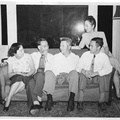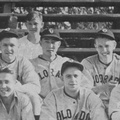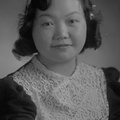Read Part 2 >>
World War II furthered diversity in the university’s faculty roster, which came to include 165 Japanese American sensei among the 179 recorded instructors of the U.S. Navy Japanese/Oriental Language School. Aside from Japanese American sensei, Japanese American names began or continued to appear in the directories between 1942 and 1945. Japanese American wives of sensei found other work at the labor-short, wartime university. Among those who worked at the Boulder campus were: Mabel Inouye (chemistry, 1943); Ike Tai (bureau of High School visitation), and Fumi Tomita (correspondence instruction, 1944). Likewise, Japanese Americans hired on in other staff capacities: Paul M. Nakagawa (Assistant in Printing Department 1941), George Kitagawa (student assistant in the Printing Department 1943), Yoshi Noguchi (student assistant in the Printing Department 1944), Mitsuko Terasaki (student assistant in the Printing Department, 1944), Norma J. Kuzara (clerk, School of Business 1946.1
"Alien enemies," or Japanese nationals were not allowed to attend the university, a policy which affected some Amache inmates. U.S. Navy objections to Japanese American internees filling the quota of 60 non-resident enrollees can be traced to the classified secret naval schools which had been established at CU. Aside from the language school, the navy had activated a radio school and a pre-radar school at the university in 1942. The FBI and army authorities were continually fine-tuning their policies with regards to wartime exigencies and the university’s effort to be inclusive.
On February 18, 1944, Professor Dyde, reported to the CU Board of Regents suggesting new policies in light of the new directives from the Provost Marshal General's Office, which governed Japanese and Japanese American attendance and employment at universities. Dyde's thorough memorandum demonstrated once again the winding road the university walked in matters of race and ethnicity. The U.S. Army wanted all Japanese and Japanese Americans to fill out questionnaires prior to attendance or employment at universities. A total of 150 forms were handed out for applicable students, faculty, and staff. No alien Japanese were admitted, but a large number of Nisei internees were employed on grounds, dormitory, and physical plant crews.
The time-consuming prescreening of Japanese American employees presented problems for the timely employment of suitable Japanese workers on the labor-starved campus. Furthermore, neither Dyde nor the Regents were eager to apply such prior screening to Nisei from Colorado. These Coloradans continued to be accepted "without restriction on account of ancestry." The students would fill out questionnaires after their admission, then the Regents would place the onus on the Provost Marshal General's Office to provide cause for disenrollment should cause be found.
But as a nod to conditions in Boulder and to those who thought CU soft on Japanese, Dyde suggested the lowering to 25 the limit of non-resident Japanese American attendance and holding Japanese employees at current levels. Since this restriction was much higher than the number currently attending, it might look to Boulder as if CU was tightening up, while it was in fact not imposing an undue hardship on Japanese American applicants. On July 11, 1944, all military clearance restrictions against Japanese Americans were dropped. Nevertheless, Boulder's city council refused to follow suit. In December, 1944, a quota for Japanese Americans at CU was set at 90, allowing the ratio of Colorado residents and non-residents to vary. But, again, the number of combined resident and non-resident Japanese American students never reached that number.2
Early in July of 1942 instructors arrived for the new U.S. Navy Japanese Language School. Predominately Japanese American, they arrived with their families in Boulder. Some of the instructors had moved with the school from the University of California, others were recruited from transit and detention camps. Both the university administration and the cadre of the U.S. Navy Japanese Language School largely mitigated an expected negative reaction in Boulder by meeting beforehand with various town groups, the newspaper editor, and businessmen.
They were right to worry, as neither Boulder citizens nor their elected officials were enthusiastic about welcoming Japanese Americans into their midst. Campus leaders stressed the vital military nature of the school and the absolute need for Japanese American instructors. In addition, uniformed students often accompanied their teachers off campus, further identifying the Japanese American instructors with the war effort. As a result, neither Japanese American students nor Japanese Language School instructors were confined to a ghetto in the city. Their residences were scattered from the hill to downtown. The university paid the Japanese American instructors on a par with the wages of other non-Japanese American, untenured language instructors.

Group of instructors grading papers at the JLS for Navy & Civilian students at the University, Roger Pineau Collection, 06_05_00_19j, Archives, University of Colorado Boulder Libraries.
Notes:
1. Directory of Students and Faculty of the University of Colorado, (Associated Students of the University of Colorado, 1942-1945) 1941, p. 59, pp. 50, 57; 1943 Supplement 33; 1944, pp. 55, 59; 1944 Supplement, p. 45; 1945, p. 80; and 1946, pp. 111, 121.
2. Board of Regents' Minutes, January 2, 1944-December 27, 1945, p.17, Exhibit D, Memorandum to President Gustavson, February 7, 1944, p.72, Exhibit F, Rex A. Ramsey to R.G. Gustavson, July 11, 1944, AUCBL; on C.U.'s need for labor and their attempt to hire out of Amache, and failing due to higher wages in the camp, see W.F. Dyde to Robert L. Stearns, November 18, 1942, Robert L. Stearns Collection, 21-2, AUCBL; Dean Dyde's concern for the rights of immigrants and citizens might have derived, in part, from his own status as a naturalized U.S. citizen of Canadian birth, see employment record, Walters Farrell Dyde, President's Office Papers, I-58-6, AUCBL; Boulder City Council Minutes, July 1944, Carnegie Branch, Boulder Public Library.
© 2014 David M Hays






